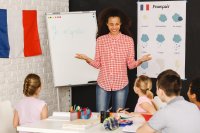Student-Centered World Language Classrooms
A district has overhauled instruction by focusing on project-based learning and communicative proficiency rather than grammar.
Your content has been saved!
Go to My Saved Content.World language teachers have one goal: to develop students’ ability to communicate in the target language. Over the last 30 years, the field of world language education has undergone a major paradigm shift, moving away from verb conjugation charts, grammar rules, and vocabulary lists toward student-centered activities that provide target language input in a meaningful and authentic way.
With the release of Can-Do Statements by the National Council of State Supervisors for Languages and the American Council on the Teaching of Foreign Languages (NCSSFL-ACTFL), most recently updated in 2017, teachers across the nation began to focus on language learning experiences centered on building communication skills, asking the critical question: What can students do with the language? Although the origins of this movement can be traced back to the early 1990s, the effects of the shift are still gradually making their way into classrooms to impact how educators teach content.
This shift requires a reimagining of some tried-and-true methods, instructional practices, and resources—no easy task for many veteran educators.
For Washington, DC Public Schools’ Global Education team, the shift meant creating a new open-source curriculum, backwards-mapped using the NCSSFL-ACTFL Can-Do Statements, the World-Readiness Standards for Learning Languages, and AP themes.
In the spring of 2016, we collaborated with seasoned DCPS teachers to develop materials that provided authentic communicative experiences. We used principles of Understanding by Design, and one of the first questions was how to assess student learning. If we were going to ask teachers to step away from vocab quizzes and fill-in-the-blank tests as the main modes of assessment, we had to provide a viable alternative.
That alternative appeared in the same semester, when the district’s Office of Teaching and Learning announced a new initiative known as Cornerstones—a series of high-quality, powerful lessons that students engage in through the DCPS units of study across grade levels and content areas, including English language arts, math, science, social studies, art, health, physical education, and world languages.
Cornerstones are developed by DCPS teachers, and are designed for students to make meaningful real-world connections to engaging and rigorous content through proven, high-impact instructional models. We determined that we could use Cornerstones to create project-based learning assignments for our world language units.
Design
Project-based learning has always thrived in the world language classroom—we wanted to capitalize on this to create meaningful projects that aligned with the skills students need to be effective communicators. To do this, we turned to Integrated Performance Assessments, also known as IPAs, to assess unit content. IPAs are cluster assessments, with each task designed to evaluate one of the three modes of communication—interpretive, interpersonal, and presentational. Well-designed IPAs include one authentic real-world scenario and three interconnected tasks, and often engage students in solving a problem or creating a product.
Starting with the Can-Do statements for each unit, we designed tasks that could measure student mastery of the content knowledge from the unit and students’ ability to apply it to real-life communicative tasks. A team of DCPS teachers created the assessments, including lesson plans and student-facing materials, and translated them into six of the seven target languages we offer.
Considerations for students with special needs and heritage and native speakers, and strategies for family engagement, were all developed alongside the content. Teachers created the outline for the Final Course IPAs, which would holistically measure Can-Do Statements and skills developed throughout the course. In the first year, a total of 28 projects were created across seven grade bands.
Implementation
This assessment approach was a shift for more than a few teachers. We knew that to ensure a successful rollout, teachers would need to be supported and trained appropriately. For the first round of new projects, this meant targeted professional development on the Cornerstones projects. We hosted district-wide sessions on the projects with teachers, focused on the instructional methods for successful implementation, and created a safe space for teachers to identify and discuss potential challenges.
As part of the Cornerstones initiative, any required specialty materials and resources were provided by the District and distributed to schools. Teachers implemented projects throughout the year, and students had the opportunity to engage in a variety of experiences.
Some students created an online educational justice campaign; others learned how to discuss improvements they would like to see in their school community, culminating in an advocacy letter to the Chancellor of DCPS about improving their school community. And other students discussed how to welcome newcomers into their school community, culminating in the creation of a welcome packet to help transfer students adapt to their new school.
Across all Cornerstones, world language teachers were able to use project-based learning as a deeper, more meaningful assessment tool that truly demonstrated what students can do.
